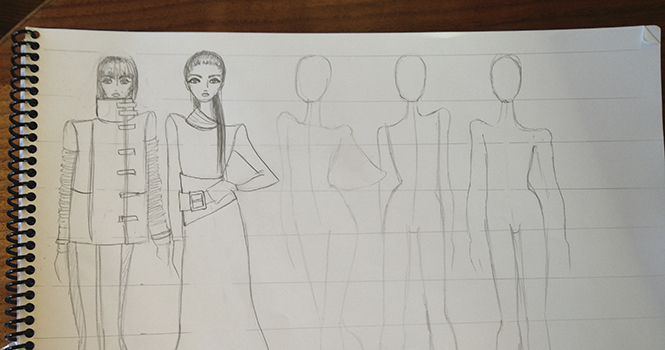The art of contrast
November 16, 2012
The “Art of Contrast: Around the World” fashion show
When: Friday from 8 to 10 p.m. Doors open at 7:30 p.m.
Where: KSC Ballroom
Tickets: Sold through Friday until 4 p.m. at Rockwell Hall; $7 per ticket
For the last four weeks, Erin Marvinney has designed, crafted and perfected her submission for the “Art of Contrast: Around the World” fashion show. Her final design will take the runway tonight at 8 p.m.
Her progression from paper to product has been filled with time crunches, cost issues, all-nighters and, ultimately, a finished design in the nick of time.
“You need inspiration,” said Marvinney, junior fashion design major. “Make sure you have something that you can really dive into.”
“From there, start to come up with as many ideas as you can. Come up with a specific person that you want to design for or else you can get completely lost in the process. You have to keep reworking ideas until you get to a point where you find something that you’re completely happy with.”
Stage 1: Oct. 16, Research and sketching
One month ago, Marvinney, who won spring’s “Rock the Runway” competition with her design partner Amy Tiefermann, began to research design themes and sketch ideas. This initial brainstorming marked the beginning of what would eventually be a finished design submitted for competition.
Marvinney, for her theme, decided on Russia.
“I kind of just meshed Russian designers that I’m interested in right now into a feeling of Russia, as opposed to a literal translation,” Marvinney said. “I either wanted to put a lot of time and effort into a really cool, chunky coat or a simple dress with an interesting belt detail, something that was really soft and feminine, but with a big punch of ‘We are Russia!’”
Marvinney decided to fashion her dress from only two fabrics: leather and jersey. When it comes to sketching, Marvinney uses repetition to refine her concepts — she reworks and reworks the drawing until she runs out of ideas.
Stage 2: Nov. 6, Finalizing the design
Marvinney didn’t touch the sketch until three weeks later. She decided what to keep and what to change, and then she finalized the sketch — it would be a mermaid-cut, deep-blue gown with a belt detailing.
“Changes in the belt buckle were made due to time,” Marvinney said about the design’s centerpiece. “It was just a matter of finding the right buckle.”
She also opted to simplify the collar, which she thought would show better on the runway.
“In all honesty, the reason I changed the collar from a cowl neck to a turtleneck was for time purposes. Plus, I thought a sturdy collar would portray more of a wintery feel then a cowl neck,” Marvinney said.
Stage 3: Nov. 13, Fabric, draping and pinning
With the clock ticking, Marvinney began to design the garment one week later.
“I’m currently draping this,” Marvinney said, rolling a mannequin towards her. “So I measure out and cut how much I want. For this piece, I had to drape the whole centerpiece. I measured from up here,” she said, pointing to a preliminary collar, “to down as far as it would go, then across the chest and finally I cut a piece that’s slightly larger than that and then fit it.”
Marvinney, cupping her head in her hands, said balancing this project with schoolwork has been, in a word, awful.
“Why do you think I’m doing it the night before it’s due? It’s all about time management,” Marvinney said.
Stage 4: Nov. 14, Final touches and knowing when to walk away
The following morning — just two days before the garment hits the runway— Marvinney completed her dress and took a step back to ponder her design and work on final touches.
“There are always times to walk away from a design,” she said. “I tend to get stuck throughout the construction process. Cutting may not go right or a machine may not be cooperating. Walking away is key to keeping sane and productive in the workroom. However, knowing when it’s done is just generally when I feel happy with the appearance when I step back.”
Marvinney said the finished product has stayed true to the original sketch; it took about 22 hours to sew the dress.
“If I were ever fully confident in a look, something would go way wrong during the show,” Marvinney said. “I chose to not overcomplicate my workload with this show. So for what I gave myself to work with, I’m happy. … All designers have different techniques and processes. Design is a constant process of learning and changing. The second any designer thinks they are done learning is the day they need to hand in their scissors and quit.”
Contact Alicia Crabtree at [email protected].












